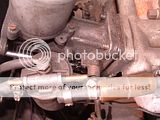Hi folks, I've had an issue for a long time that I've been trying to figure out.
My vehicle is a '60 TR3A. When I brake even slightly hard, the rpms drop way down, even to the point of stalling sometimes. This only happens when the car is warming up, or on a cool day when the engine doesn't get quite as warm.
I suspect a throttle linkage issue because if I lift the accelerator pedal with my foot instead of pressing it I get a very similar symptom. I've been through the entire linkage. All the ball joints are good. I saw another thread about play in the bell crank, and I have a bit of that, but not too bad.
Is it possible that the car is flexing when braking? This might have the same effect as lifting up the accelerator.
Any ideas?
My vehicle is a '60 TR3A. When I brake even slightly hard, the rpms drop way down, even to the point of stalling sometimes. This only happens when the car is warming up, or on a cool day when the engine doesn't get quite as warm.
I suspect a throttle linkage issue because if I lift the accelerator pedal with my foot instead of pressing it I get a very similar symptom. I've been through the entire linkage. All the ball joints are good. I saw another thread about play in the bell crank, and I have a bit of that, but not too bad.
Is it possible that the car is flexing when braking? This might have the same effect as lifting up the accelerator.
Any ideas?

 Hi Guest!
Hi Guest!

 smilie in place of the real @
smilie in place of the real @
 Pretty Please - add it to our Events forum(s) and add to the calendar! >>
Pretty Please - add it to our Events forum(s) and add to the calendar! >> 
